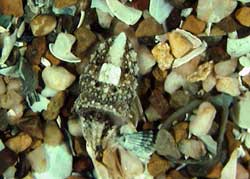Cuttlefish Masters of Disguise Despite Colorblindness

Cuttlefish are wizards of camouflage. Adept at blending in with their surroundings, cuttlefish are known to have a diverse range of body patterns and can switch between them almost instantaneously.
While previous research has reported cuttlefish colorblindness, MBL Research Associate Lydia Mäthger and her colleagues in Roger Hanlon’s laboratory approached the problem in more depth and with a new behavioral assay. The researchers tested cuttlefish (Sepia officinalis) color perception through observing the animal’s behavioral response to a series of checkerboard patterned substrates of various colors and brightnesses.
They found that the animals did not respond to the checkerboard pattern when placed on substrates whose color intensities were matched to the Sepia visual system, suggesting that these checkerboards appeared to their eyes as uniform backgrounds. However, their results showed that cuttlefish were able to detect contrast differences of at least 15%, which Mäthger and her colleagues suspect might be a critical factor in uncovering what determines camouflage patterning in cuttlefish.
Despite these results, the vexing question of how cuttlefish master the task of camouflage in low-contrast, color-rich environments such as those found at shallow depths of water, remains to be answered. Mäthger and her colleagues are currently looking at cuttlefish contrast sensitivity in more detail. “Our result that cuttlefish are able to detect contrast differences of at least 15%, is only an upper limit,” says Mäthger. “It’s certainly not the contrast threshold, which we would like to know. It seems that cuttlefish camouflage themselves by matching intensities of objects in the environment and we’re collecting data to test see whether this is really the case.”
In addition to looking at contrast between different objects, Mäthger and her colleagues are testing a variety of other optical clues, in particular, cuttlefish perception of object edges, brightness, and sizes of objects.
Cuttlefish are cephalopods, relatives of octopuses and squid, and are found in all marine habitats worldwide; they are particularly abundant around coral reefs and temperate rock reefs in which the visual habitat is richly varied. Cephalopods can change their appearance with a speed and diversity unparalleled in the animal kingdom. Some squids, octopuses, and cuttlefish can show 30-50 different appearances. Their sophisticated neural control of the skin make cuttlefish an excellent model for studying camouflage.
Media Contact
More Information:
http://www.mbl.eduAll latest news from the category: Life Sciences and Chemistry
Articles and reports from the Life Sciences and chemistry area deal with applied and basic research into modern biology, chemistry and human medicine.
Valuable information can be found on a range of life sciences fields including bacteriology, biochemistry, bionics, bioinformatics, biophysics, biotechnology, genetics, geobotany, human biology, marine biology, microbiology, molecular biology, cellular biology, zoology, bioinorganic chemistry, microchemistry and environmental chemistry.
Newest articles

Properties of new materials for microchips
… can now be measured well. Reseachers of Delft University of Technology demonstrated measuring performance properties of ultrathin silicon membranes. Making ever smaller and more powerful chips requires new ultrathin…

Floating solar’s potential
… to support sustainable development by addressing climate, water, and energy goals holistically. A new study published this week in Nature Energy raises the potential for floating solar photovoltaics (FPV)…

Skyrmions move at record speeds
… a step towards the computing of the future. An international research team led by scientists from the CNRS1 has discovered that the magnetic nanobubbles2 known as skyrmions can be…





















